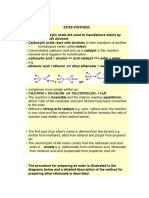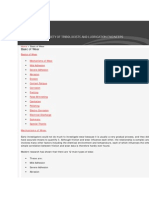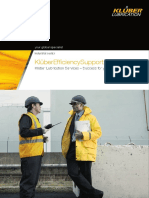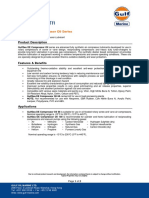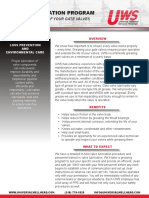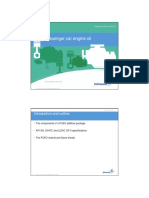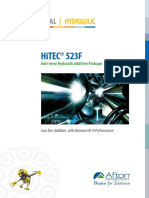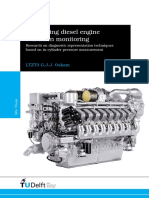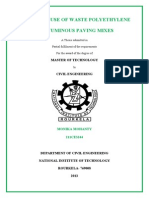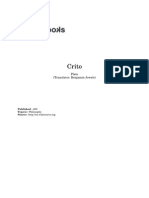Lube Tech025 Oil Cleanliness
Lube Tech025 Oil Cleanliness
Uploaded by
lahiru1983Copyright:
Available Formats
Lube Tech025 Oil Cleanliness
Lube Tech025 Oil Cleanliness
Uploaded by
lahiru1983Original Description:
Original Title
Copyright
Available Formats
Share this document
Did you find this document useful?
Is this content inappropriate?
Copyright:
Available Formats
Lube Tech025 Oil Cleanliness
Lube Tech025 Oil Cleanliness
Uploaded by
lahiru1983Copyright:
Available Formats
N0.2!
;;:
OIL CLEANLINESS
The effectiveness of lubricants in preventing wear can be seriously required cleanliness levels. The current standard provides a 3-part
compromised by the presence of contaminants such as particulates code to represent the number of particles per millilitre (ml) of fluid
and water in the lubricant. greater than 2 11m, 5 11m, and 15 11m, respectively. The current
Where sliding surfaces are separated by an oil film (hydrodynamic standard is ISO 4406:1987(E). The ISO is now circulating a draft
lubrication), wear rates of the two surfaces arising from the presence proposal. ISO/DFIS 4406:1999(E), for contamination levels measured
of particulate contaminants increase rapidly when the sizes of the with automatic particle counters calibrated in accordance with ISO
particles exceed the running clearances between sliding surfaces. 11171. In the proposed standard, the three parts signify the number
of particles/m! greater than 4!lm, 611m, and 14!lm respectively (scale
The quantity and size of particulates in the lubricant is therefore one
or range numbers R41RG/R,4). ) Many laboratories will report either a
of the most important factors affecting the service life of the
2-part code, or a 3-part code, as specified by the user. The 2-part code
lubricated components of all machinery. (For the purposes of this
refers to particle counts in the 5 11m and 15 11m size ranges. A 3-part
article, and in keeping with common industry practice, the terms
code of 17/14/12, for example, would indicate 640 to 1,300
"clean" and "cleanliness" refer to the amount and size of particulate
particles/m! greater than or equal to 2 11m, 80 to 160 particles/m!
contamination in a lubricating or hydraulic fluid). The effect of
greater than or equal to 5 11m, and 20 to 40 particles/m I greater than
particulate contamination varies with the type of system and
or equal to 15 11m. Notice each step in the ISO code represents either
lubrication environment, in that some environments are more
double or half the particle count relative to an adjacent code. lt is
sensitive to particulate contamination than others. In hydraulic
important to note the "/" character in the written form of the code is
systems, for example, clean fluid is absolutely essential for successful
merely a separator, and does not signify a ratio of the scale numbers.
long-term operation. Also, machines equipped with rolling element
bearings are especially sensitive to particulate contamination, Studies of "new" turbine oils, crankcase oils, hydraulic fluids, and
although machines using fluid-film bearings are not immune to such bearing oils delivered to customers indicate varying degrees of
damage. Many sources cite dramatic improvements in expected cleanliness, with ISO codes from a low of 14/11, to as high as 23/20.
machine life resulting from even modest improvements in lubricant Drum-delivered products were generally found to be cleaner than
cleanliness. bulk-delivered products. Referring to Table 1, one might think twice
before putting "new" oil with an ISO 23/20 measurement in a
QUANTIFICATION OF PARTICULATE CONTAMINATION. machine. Improper storage procedures can contribute additional
The question of quantification of oil cleanliness raises a number of contamination to new oil. Poor handling practices are another source
issues such as of new oil contamination . lt is important to identify all vessels are
• How clean is "new" oil? used in the plant for transporting and adding makeup oil, and to
ensure that they are in an adequate state of cleanliness. After
• How clean does the oil need to be?
implementing cleanup programs, many users find the dirtiest oil in
• What improvements in machine life can you expect from cleaning their plant is incoming "new" oil. lt is clear that proper filtering of
up your oil? new oil during or before filling is a prudent and highly desirable
• What about other types of contamination? practice to extend machine life. Each machine class should be
• What steps can you take to clean up your oil? evaluated for cleanliness levels appropriate to the application. In
general. machines with tight clearances and/or anti-friction (rolling
The standard test procedure for assessing the cleanliness of hydraulic element) bearings benefit greatly from very clean oil. Turbine electro-
fluids is ISO 4406, which establishes the relationship between particle hydraulic control (EHC) systems and many aero-derivative gas turbines
counts and cleanliness. Although originally developed for application are examples of industrial machines that require extremely clean oil
to hydraulic fluids, common practice for proper performance and long life. Filter systems rated to remove
ISO Code Minimum Maximum
has now extended the application of particles as small as 3 11m to 7 11m are commonly used in such
the standard to many other types of 10 5 10
11 10 20 applications. Hydraulic systems' targets should also be adjusted to
lubricants. This international cleaner levels for higher system operating pressures.
12 20 40
standard uses a code system to 13 40 80
quantify contaminant levels by Table 2 presents some typical base lubricating oil cleanliness targets
14 80 160
particle size in micrometers (!lm). 15 160 320 for common machines and machine elements. Like most guidelines,
Using ISO 4406, a machine 16 320 640 these targets are suggested as
Machine/element ISO Target
17 640 1300 starting points. lt may be
owner/operator can set simple limits Roller bearing 16/14/12
18 1300 2500 necessary to make adjustments to
for excessive contamination levels, 19 2500 5000 JournaTOearing 17/15/12
based on quantifiable cleanliness these levels once the response of Industrial gearbox 17/15/12
20 5000 10000
measurements. 21 10000 20000 machinery on a particular site has MoblTe gearbox 17/16/13
22 20000 40000 been evaluated. D1esel engine 17/16/13
Table 1. ISO 4406 fluid cleanliness Steam turbine 18/15/12
23 40000 80000 Table 2. Typical base cleanliness
codes (particles per ml.). Paper marnine 19/16/13
targets.
Table 1 illustrates the ISO 4406 cleanliness codes. (The ISO standard
calls the codes "scale numbers." They may also be referred to as Studies performed in many industries all show dramatic extensions in
"range numbers" and represented as Rs/R,s for 2-part codes and · expected machinery life by improving lubricant cleanliness. In one
Rz/Rs/R,s for 3-part codes.) This standard allows the quantification of example, a reduction of particles larger than 10 11m from 1000/ml to
current particulate cleanliness levels and also to set targets for 100/ml resulted in a 5-fold increase (Continued on Page 11)
tto . 2~:; • Dm;ml!Ul 2002 DJ
(Continued from Page I)
in machine life, which must be an attractive return on cleanup removes some, but not all, wear particles. In fact, many full -flow
investment. An additional benefit of cleaner oil is a lower noise floor filtration systems are only effective in removing particles larger
for wear particle detection measurements. lt is much easier to detect than 40 11m. Concentrating on the hardest and most abrasive
subtle changes in the amount of wear debris in a clean system than in particles is an effective strategy for this category of contam inants.
a dirty one Once the contamination sources are identified, you can concentrate
The Society of Automotive Engineers (SAE) studies have shown engine on the areas most likely to generate your target cleanliness levels.
wear reductions of 50% when filtering crankcase oil to 30 11m, and Consider the case of a typical practical application, i.e. a diesel
70% when filtering to 15 11m, as compared with filtering to 40 11m . crankcase lubricant filtration system.
However, some investigators have reported that the presence of a
A full-flow Barrier filter will normally have a pore size ranging from
certain concentration of fine sub-micron particles was beneficial as
15-50 11m, although differences often arise in the figures quoted due
they aided polishing of bearing surfaces over an extended period
to confusion over the use of absolute vs. nom inal f ilter ratings. Such
thereby reducing friction.
barrier media filters are therefore normally only capable of removing
Lubricant film thickness in fluid-film journal bearings is substantially the largest contaminant particles, and w ill not cope with
larger than that found in rolling element bearings, and hydrodynamic accumulation of soot, the pore sizes being at least an order of
pressures are typically lower. However, the Babbitt in these bearings, magnitude larger in pore size than the majorit y of particles circulating
being composed primarily of lead and tin, is susceptible to oxidation in the lubricant. To provide a full-flow f ilter wh ich would remove
damage from water and oxygen. Water can also reduce the load- particulate debris of less than 111m, the filter wou ld need to be
carrying capacity of a fluid-film bearing lubricant sufficiently to cause unacceptably large in order to obtain acceptable f low rates and
journal-to-bearing contact (wiping). The reduction in film thickness pressure drops. However, if a small proportion, normally some 10%, of
also increases the in order to establish and maintain an oil clean-up the lubricant is diverted through some form of by-pass fi lter which is
programme it is necessary to: - effective in retaining these very small particles, the lubricant will
• Measure and evaluate current cleanliness levels to establish eventually achieve a high level of cleanliness, if the f iltration removal
baselines for comparison. rate exceeds the generation rate of the small particulates, wh ich is the
• Examine and evaluate current storage and handling practices. case in practice. A variety of by-pass filter types have been evaluated,
all of which are generally effective in purifying the lubricant to a
• Set cleanliness targets based on your goals for longer machine life
greater extent than is possible with the normal full -f low f ilter, but
and/or reduced maintenance and downtime costs.
there are differences in qualitative and quantitative performance
• Evaluate, select, and implement the improvements in filtration, levels according to the filter type. A number of papers have been
storage, and handling procedures required to achieve the goals. published on the subject of the use of by-pass filtrat ion systems
• Measure and trend your progress. Barrier filtration of particulate material to the sub-micron level is
• Document the impact of your investment on availabil ity, possible, but the system suffers from a number of drawbacks. As the
maintenance expense, and machine life. filter becomes progressively loaded with contaminant, the flow rate
With these elements delineated, some of the practical aspects of through the filter drops, falling to zero when the filter becomes
improving filtration, storage, and handling procedures can be completely blocked. However, before this stage is reached, the filter
addressed. membrane may well rupture or channel at high inlet pressures,
allowing unfiltered oil to pass through . Filtration Ratings of barrier
Many improvements to your filtration, storage, and handling
med ia filters is expressed as either the Filtration Ratio ~' or the
procedures can be made with minimal cost. A little time spent simply
Filtering Efficiency 11·
reviewing your current storage and handling procedures can be
revealing . During the evaluation phase, it is important to identify ~ = Cup I Coown
contamination sources as well as the levels. Contamination sources Where Cup =Concentration of particle entering the filter
may include: Coown = Concentration of particles leaving the filter
• Contaminated new oil. As previously mentioned, new oil is The particle count size is normally expressed as a subscript, e.g . a filter
often not as clean as you might think, usually becoming with a rating of "~ 2 = 100" would allow one particle through for
contaminated during transportation, storage, and handling. every 100 particles of size 2 11m entering the f ilter. The Filtering
• Built-in contamination. Machine components can become Efficiency 11 is defined as the Upstream- Downstream Particle Count
contaminated from handling practices encountered during of a given size (x) divided by the Upstream Particle Count, i.e.
overhauls or rebuilding processes. lt is important to review shop 11x = (1-1/~x) X 100
procedures relating to cleanliness of internal wetted parts, hoses, There are a number of standard test procedures to evaluate filter
and lubricant piping. efficiencies over a period of time as the f ilter blocks. Since filter
• Ingested contamination. Unfiltered sump vents and faulty seals blocking results in an increase in the differential pressure drop across
are common problems, which can result in contaminants (including the filter, test procedures also measure this pressure drop. In Test
water as well as particulates) entering the lube system from the Procedure J1858, the times taken for the pressure drop to increase by
outside environment. Minor modifications to vent systems can 80% and 100% respectively are recorded, and upstream and
reap rewards in this area . downstream particle counts are evaluated simultaneously every 10
• Internally-generated contamination. Recirculating wear minutes. This test procedure stipulates the use of test oil conforming
particles through machine components can create a self-fulfilling to SAE J1260, and a contam inant conforming to SAE 5-80 11m.
prophecy of machine destruction. Normal full-flow filtering Test Procedure ISO 4572 records the time taken for the initia l pressure
NO 2!:: • Dm:mu~ 2002 [ill
drop to increase by 5%, 10%, 20%, 40%, 80% and 100% respectively. which it passes into the heated evaporation chamber in the form of a
The oil type is specified within the standard and the contaminant is thin film, where, after heating to temperatures ranging from 100 to
specified as Air Cleaner Fine Dust or any other 150-approved 150°C, the subsequent pressure drop to atmospheric assists the rapid
equivalent. Methods for evaluating filtration efficiencies are fully removal of the lower-boiling contaminants described above.
described in a number of standard procedures, including: The vented contaminants are directed back into the induction system
SAE Standard No. J1858, 1988, "Full Flow Lubricating Oil Filters - and subsequently consumed during the combustion process. In
Multi-Pass Method for Evaluating Filtration Performance". practice, it has been found that an operating period of some 10,000
miles was necessary for the refiner to clear the lubricant of
SAE Standard No. HS-806, 1994 "Oil Filter Test Procedure".
contaminants, regardless of whether the engine was new or old, and,
SAE Standard No. J1985, 1993 "Fuel Filters - Initial Single-Pass once cleared, the lubricant remained virtually free of harmful solids
Efficiency Test method" . and liquids. For reasons which have not satisfactorily been explained,
ISO Standard No. 4572, 1981 "Hydraulic Fluid Power- Filters- Multi- it appears that the lubricant which has been subjected to the cleaning
Pass Method for Evaluating Filtration Performance" . up treatment by such a refiner is claimed to have an improved film
One such type of by-pass barrier filter, developed and proven in the strength compared with the original, which, as would be expected,
US using technology based on human blood dialysis, diverts a small results in decreased wear of engine components.
continuous stream of engine oil (5%-7%) through a specially Again, for reasons which are difficult to comprehend, tests have
designed filter element that uses a machine wound string of shown that the emission levels of NOx, carbon monoxide, particulates
cotton/cellulose fibre. As it cleans the oil, the filter traps particulates and smoke are reduced when such a refiner is incorporated into the
down to 3 microns and removes water. This system claims to overcome lubrication system, after an initial acclimatisation period . These
channelling by using computer controlled winding machines that systems would be most beneficial when used in vehicles subjected to
control both weave and tension of the wind to produce woven filter intermittent use with frequent need for cold starts, e.g. school buses.
elements. These are wound on a stainless steel core resulting in a lt is this pattern of use which is most likely to result in the problem of
varying density filter progressing from a 40 micron weave at the outer fuel dilution of the lubricant. If the lubricant becomes excessively
diameter to a 1 micron capability at the core. The weave is designed thinned by fuel dilution, the hydrodynamic barrier which separates
so that there is an equal resistance to flow throughout the filter. the moving parts within a bearing becomes thinner and less durable,
With no shortcuts available, the oil must pass completely through the with the consequence that the smaller particles within the oil become
filter element. effectively more abrasive. This problem would be most readily
This system is also claimed to remove water as a result of an 80% overcome by using a refiner to evaporate off the lower-boiling fuel.
cotton content in the makeup of the filter element which retains Such refiners are also effective in eliminating 'acid-pitting', which is
moisture in suspension within the individual fibres until it reaches caused by an accumulation of acidic by-products in the lubricant.
saturation. This compares with paper/wood cellulose, glass or A further option is the use of a Centrifugal filter.
synthetic fibres used in conventional full flow filters which are By-pass Centrifugal oil cleaners may be externally powered or self-
virtually ineffective in absorbing water. powered. The latter type are generally much smaller, and can be used
This system has been extensively trial led in the US, where the tripling in a variety of fixed (e.g. cleaning of quench oils and hydraulic oils)
or even quadrupling of oil life has been cla imed . and mobile (e.g. commercial vehicles) applications. In a typical
A further development of the barrier filter incorporates a heating example, the centrifuge cleaner will consist of a body with outer
chamber, or 'refiner' the purpose of which is to remove water, casing and a central spindle around which a rotor revolves at high
unburnt fuel, acids, antifreeze and other low-boiling contaminants speed. The oil, which is under pressure, enters the centrifuge body
from the lubricant on a continuous basis. and continues to the cleaning chamber of the rotor via the centre
spindle. Having passed through the cleaning chamber, the oil exits at
As destructive as particulate contamination can be, these other
the base of the rotor via tangentially opposing nozzles. The oil exiting
contaminants also contribute to oil degradation and premature
from the rotor causes the rotor to revolve at high speed, i.e. up to
machine wear. Water alone is a significant factor in lubricant
10,000 r.p.m . Thus creates a centrifugal force within the rotor which
degradation. When combined with iron or copper particles, water
can exceed 3000g, which causes separation of contaminants which
becomes even more aggressive in attacking lubricant base-stocks and
differ in density from that of the oil. They migrate outwards, forming
additives. The adverse effects of water in oil include:
a dense 'cake' on the inside surface of the rotor wall. The rotor may
o Lubricant breakdown, through oxidation and additive then be either cleaned out or replaced with a new unit at the
precipitation. appropriate time. For optimum performance, it is essential that the oil
o Changes in viscosity, affecting the ability of a lubricant to maintain entering the centrifugal filter is as hot as possible, so that the density
the film thickness necessary to protect the lubricated surfaces. and viscosity are at their lowest which will facilitate the migration of
o Corrosion. contaminants. Also, the oil should be delivered at high pressure, so
that high centrifuge speeds are obtained, generating high centrifugal
o Accelerated fatigue of lubricated surfaces. forces. The ideal positioning for the centrifuge cleaner is therefore
Even very small amounts of water can be harmful in machines immediately downstream of the oil pump. lt is also necessary to
equipped with rolling element bearings. ensure that oil drainage route from the cleaner, normally directly back
These refiners have also undergone extensive trials, and lubricant into the sump, is free of any obstruction so that no flooding of the
lifetimes in excess of 800,000 miles have been claimed in commercial rotor can occur which would reduce its speed.
diesel engines. In practice, the lubricant first passes through a fine The basic principles involved are fairly basic and simply explained.
barrier-type filter, of a type similar to that described above, after Consider the case of a spherical contaminant particle of diameter dp
N0.2!; • Dw;m~tll 2002 [ill
and density PP suspended at a radius r in a fluid with density po and Only free water is removed.
dynamic viscosity jlo. If we then asume that the fluid and the Centrifuging (Centrifugal Separation)
contaminant particle are both rotating about a vertical axis at the
Only the free water form of water is removed to about 20 ppm
same angular velocity m, then the centrifugal force acting on a
particle would be: by weight, above the saturation point.
Entrained gases aren't removed.
where: Emulsified water content tends to increase.
f, is the centrifugal force acting on the particle Dirt and other solids are removed.
mp is the mass of the particle Additives can be removed by this method.
r is the radius
Coalescing Filters/Screens
m is the angular velocity.
Opposing this force is the effect of the viscous drag upon the particle Only free water is removed .
(fd) which is a function of the Reynolds number and the particle drag A coalescing cartridge filter is used to separate the water from
coefficient. If we assume that Stoke's law will apply to the migrating the oil.
rate of the particle, then the time taken "t for the particle to travel a Additives can be removed by this method.
distance r to the rotor wall is
Only effective for narrow ranges of viscosity and specific gravity.
"t- 18~ ln((r + ~rl/rl Some manufacturers claim "No removal of additives. "
d 2p~pm 2
Filter/Dryers
where ~p is the difference in density between the contaminant
particles and the oil (pp - po.) Cartridge-type filters that use super-absorbent materials to soak
From this last equation, it follows that separation of the particles is up water.
more rapid the lower the viscosity of the oil, as would be expected. Dissolved water isn't removed.
Also, the shorter the distance that the particle has to travel under a
given set of throughput conditions, then the smaller is the size of Vacuum Treating (Vacuum Dehydrating)
particle which can be removed . The wet lubricant is heated in a vacuum to separate the water.
The superiority of the performance of centrifugal cleaners of this type Additives usually aren't removed from the lubricant, since it is a
compared with conventional barrier filters has been thoroughly
chemical separation .
investigated under laboratory conditions and in practical trials.
Dissolved, emulsified, and free water can be removed .
This type of cleaner will not separate out unburnt fuel, but does have
other advantages compared with barrier type filters in that the When combined with effective filtration media, capable of being
cleaning efficiency remains constant throughout, also particles a highly-effective lubricant purification system.
smaller than those which may pass through many barrier filters may
Gas Sparging/Air Stripping
be separated out. In practice, primary soot particles below 1~m , which
are responsible for oil thickening, may be separated out using The chem ical separation principle of air stripping is used.
centrifugal systems. The benefits of the centrifugal by-pass filtration Dissolved, emulsified, and free water are removed .
system in reducing wear values can be quantified by measurement of
Additives are not removed .
the increase in iron levels in the lubricant. lt has been shown that the
rate of increase in iron levels in an engine equipped with a centrifugal Nitrogen or air can be used.
filter is only half that compared with an engine operating without the Finally, an additional cleanup step, which is often overlooked, is to
benefit of a centrifugal filter. specify the cleanliness levels of the lubricants you purchase. You may
General water contamination pay a little more up front, but the savings in machine availability,
filtration costs, and machine life extension often more than offset the
Since the sources for water contamination are so numerous and additional cost. If you choose this route, be sure to test the incoming
ubiquitous, eliminating all sources of moisture can be very difficult. oil to verify you get what you paid for.
Removing water from oil can also be a challenging task, but there are
several methods available for use in general, non-automotive David Margaroni
situations. Each method has advantages and disadvantages, so each
must be carefully evaluated for the particular application . Some of
the common methods for removing water from oil, along with their
tradeoffs, include:
Settling/Evaporation
Natural -gravity acts on the water to separate it from the oil,
and water escapes from the fluid via natural evaporation.
Inexpensive.
Least effective of known methods.
Properly-designed reservoir is required.
N0 .2!: • l>{({ffiUil 2002 [ill
You might also like
- EHC™ Series Base Grupo II MobilDocument2 pagesEHC™ Series Base Grupo II MobildpomahNo ratings yet
- Compressor Oils: DIN 51506 VDL (Only For 32, 46, 68, 100, 150) DIN 51506 VBL (Only For 150-M, 220, 320, 460)Document2 pagesCompressor Oils: DIN 51506 VDL (Only For 32, 46, 68, 100, 150) DIN 51506 VBL (Only For 150-M, 220, 320, 460)Majed Dawa100% (2)
- ASME PTC 17-1991-Reciprocating IC Engines HighlightedDocument40 pagesASME PTC 17-1991-Reciprocating IC Engines Highlightedlahiru1983100% (1)
- Thrust Bearing CalculationsDocument162 pagesThrust Bearing Calculationslahiru1983100% (1)
- Wear Particle Analysis of OilDocument7 pagesWear Particle Analysis of OilChandan KumarNo ratings yet
- EN-M02 What Is A LubricantDocument22 pagesEN-M02 What Is A LubricantChristian Boger100% (1)
- Ester SynthesisDocument7 pagesEster SynthesisNgô Ngọc Mai PhươngNo ratings yet
- Grease Li EpDocument1 pageGrease Li EpTAREK HAMADNo ratings yet
- Oil AnalysisDocument4 pagesOil AnalysisAbdallah MansourNo ratings yet
- Sheet Metal Forming Using Environmentally Benign LubricantDocument12 pagesSheet Metal Forming Using Environmentally Benign LubricantJuliano ErcolaniNo ratings yet
- Cutting FluidsDocument28 pagesCutting FluidsVivek DesaleNo ratings yet
- E7604-1!05!09 Practical Contamination Management enDocument45 pagesE7604-1!05!09 Practical Contamination Management enAlie Bhin Abhu DhabiNo ratings yet
- Tribology-Key To Proper Lubricant Selection: White PaperDocument6 pagesTribology-Key To Proper Lubricant Selection: White PaperHarrison IziyonNo ratings yet
- LT32599 10Document38 pagesLT32599 10Angela Bailey100% (1)
- Api Engine Oil Classifications Brochure2Document13 pagesApi Engine Oil Classifications Brochure2Sinh LeNo ratings yet
- Shell Turbo T46 PDFDocument2 pagesShell Turbo T46 PDFdionisio emilio reyes jimenezNo ratings yet
- BR Pulp and PaperDocument4 pagesBR Pulp and PaperJohnNo ratings yet
- LubricationDocument49 pagesLubricationAdel KlkNo ratings yet
- Filtracion Lubricantes NuevosDocument100 pagesFiltracion Lubricantes NuevosHernan Andres GarciaNo ratings yet
- TLT Oil Analysis Flagging LimitsDocument76 pagesTLT Oil Analysis Flagging Limitsrbulnes2350No ratings yet
- Hy-Pro Gearbox Filtration OverviewDocument4 pagesHy-Pro Gearbox Filtration OverviewlubangjarumNo ratings yet
- Perma Food Grade Grease H1 SF10 TDS enDocument2 pagesPerma Food Grade Grease H1 SF10 TDS enLucas SantosNo ratings yet
- Hydraulic FluidDocument6 pagesHydraulic FluidDesiree Cena CapunoNo ratings yet
- STLE - Basic of WearDocument17 pagesSTLE - Basic of WearGerson NevesNo ratings yet
- High Temperature GreasesDocument5 pagesHigh Temperature GreasesJosé Cesário NetoNo ratings yet
- Hitec 355 PdsDocument2 pagesHitec 355 PdsAlex CamposNo ratings yet
- Hitec 307 PdsDocument2 pagesHitec 307 PdsNgũ Viên Gia CácNo ratings yet
- Fire Retardant Hydraulic FluidsDocument12 pagesFire Retardant Hydraulic FluidsPRASAD SANAPNo ratings yet
- Kluber Lubrication ServicesDocument7 pagesKluber Lubrication Servicescesar_lubNo ratings yet
- GREASEDocument18 pagesGREASEOcto Adhi W PryhantoNo ratings yet
- Flender Gear UnitsDocument74 pagesFlender Gear Unitssdk00No ratings yet
- GulfSea de Compressor Oil SeriesDocument2 pagesGulfSea de Compressor Oil SeriesObydur RahmanNo ratings yet
- Amides Summary c13319rsDocument260 pagesAmides Summary c13319rsjim_corbet1211No ratings yet
- Engine Testing and Rating: Standardized Gasoline TestsDocument32 pagesEngine Testing and Rating: Standardized Gasoline TestsJahmia CoralieNo ratings yet
- Engine Oil 15W 40 PDFDocument2 pagesEngine Oil 15W 40 PDFAngela Jackson100% (1)
- Performance Additives and Fluids: Extreme Pressure/ Antiwear Additive Selection GuideDocument4 pagesPerformance Additives and Fluids: Extreme Pressure/ Antiwear Additive Selection GuideFadhli KusumaNo ratings yet
- Valve Lubrication Program FlierDocument2 pagesValve Lubrication Program Flierclaudio godinezNo ratings yet
- Lubricants in Refrigerant Systems: Tests For Boundary LubricationDocument27 pagesLubricants in Refrigerant Systems: Tests For Boundary LubricationmelieneideaNo ratings yet
- Hitec 9490 PDFDocument2 pagesHitec 9490 PDFPranit More Arabian Petroleum LimitedNo ratings yet
- VUD Vacuum DehydratorsDocument7 pagesVUD Vacuum DehydratorsZaqueu Santos OliveiraNo ratings yet
- Passenger Car Engine Oil: Introduction and OutlineDocument18 pagesPassenger Car Engine Oil: Introduction and OutlineJahmia CoralieNo ratings yet
- TT Lubricating Oils Greases Shelf Life RecommendationsDocument2 pagesTT Lubricating Oils Greases Shelf Life RecommendationsmarymydaughterNo ratings yet
- How To Select Machines For Oil AnalysisDocument3 pagesHow To Select Machines For Oil AnalysisHari PurwadiNo ratings yet
- Chapter 6 LubricationDocument24 pagesChapter 6 Lubricationchala nigussieNo ratings yet
- E79000-3-04-15 HMI 2015 FiltersystembuchDocument311 pagesE79000-3-04-15 HMI 2015 FiltersystembuchTimon2005100% (1)
- Trib Ology RollerDocument24 pagesTrib Ology Rollerbalamurugan_meNo ratings yet
- Components: Hitec® 536Document2 pagesComponents: Hitec® 536Liliana RodriguezNo ratings yet
- Impact of Water On The Rheology of Lubricating GreasesDocument12 pagesImpact of Water On The Rheology of Lubricating GreasesKem Miatoot MacapepeNo ratings yet
- Hitec-11410 Pds WotrDocument2 pagesHitec-11410 Pds WotrAlex CamposNo ratings yet
- Lubricant Brochure 2024Document18 pagesLubricant Brochure 2024rvchawla977No ratings yet
- Aceites Lubricantes para Motores Diesel Sep-2015Document28 pagesAceites Lubricantes para Motores Diesel Sep-2015Carlos Andres BonillaNo ratings yet
- Hitec 523f PdsDocument2 pagesHitec 523f PdsPiaoNo ratings yet
- Vegetal Vs Mineral OilsDocument6 pagesVegetal Vs Mineral OilsDark CenobiteNo ratings yet
- Presentation STLE 2015 v4Document25 pagesPresentation STLE 2015 v4Carlos ZapataNo ratings yet
- Afton Chemical HiTEC-317 - PDSDocument2 pagesAfton Chemical HiTEC-317 - PDS1mmahoneyNo ratings yet
- APE Core Group 1 Sell SheetDocument1 pageAPE Core Group 1 Sell Sheetbig2yaNo ratings yet
- Article - Lubrication at BHP SteelDocument5 pagesArticle - Lubrication at BHP SteelzuhdisulaemanNo ratings yet
- Eaton Internormen Condition Monitoring SystemsDocument16 pagesEaton Internormen Condition Monitoring SystemsEaton FiltrationNo ratings yet
- Wear: Materials, Mechanisms and PracticeFrom EverandWear: Materials, Mechanisms and PracticeGwidon W. StachowiakNo ratings yet
- PIL161 Lube Oil System Cleanliness PDFDocument3 pagesPIL161 Lube Oil System Cleanliness PDFHaryNo ratings yet
- ISO4406 Cleanliness Code ExplanationDocument4 pagesISO4406 Cleanliness Code Explanationfructora0% (1)
- Diesel Engine Condition MonitoringDocument160 pagesDiesel Engine Condition Monitoringlahiru1983100% (1)
- Diesel Engine Condition MonitoringDocument301 pagesDiesel Engine Condition Monitoringlahiru1983100% (1)
- Icap 4200 Icp OesDocument4 pagesIcap 4200 Icp Oeslahiru1983No ratings yet
- Diesel Engine Condition MonitoringDocument160 pagesDiesel Engine Condition Monitoringlahiru1983100% (1)
- Element Analysis in Lubricating OilsDocument12 pagesElement Analysis in Lubricating Oilslahiru1983No ratings yet
- Piston SeizuresDocument7 pagesPiston SeizuresMoaed KanbarNo ratings yet
- Lower and Higher Heating Values of Gas Liquid and Solid FuelsDocument1 pageLower and Higher Heating Values of Gas Liquid and Solid FuelsNikunj PipariyaNo ratings yet
- Advantages of Pneumatic Control Systems: MAN B&W DieselDocument10 pagesAdvantages of Pneumatic Control Systems: MAN B&W Diesellahiru1983100% (1)
- White Paper - Oil Analysis OverviewDocument6 pagesWhite Paper - Oil Analysis Overviewlahiru1983No ratings yet
- 916 Ti-Touch, 915 KF Ti-Touch and 917 Coulometer: Compact Titrator For Routine AnalysisDocument12 pages916 Ti-Touch, 915 KF Ti-Touch and 917 Coulometer: Compact Titrator For Routine Analysislahiru1983No ratings yet
- Francis Turbine Blade ReplacementDocument44 pagesFrancis Turbine Blade Replacementlahiru1983No ratings yet
- Black Arabs in Macadomian ArtDocument10 pagesBlack Arabs in Macadomian ArtWesley MuhammadNo ratings yet
- Armor FlexDocument2 pagesArmor Flexcct_2010No ratings yet
- Chetan Kadam HR 5 YearsDocument4 pagesChetan Kadam HR 5 YearsVinay DeshmukhNo ratings yet
- A Quick Look at PTC Mathcad Prime 10Document4 pagesA Quick Look at PTC Mathcad Prime 10Truong Thanh TungNo ratings yet
- A Study On Use of Waste Polyethylene in Bituminous Paving MixingDocument106 pagesA Study On Use of Waste Polyethylene in Bituminous Paving Mixingpraveen100% (1)
- Guideline G-17 Impacto en MaterialesDocument2 pagesGuideline G-17 Impacto en MaterialesLuis OrtizNo ratings yet
- Registration Form - : Water & Power Development Authority (WAPDA)Document2 pagesRegistration Form - : Water & Power Development Authority (WAPDA)Muhammad Zaryab KhanNo ratings yet
- PD 1096 - Basic LawDocument1 pagePD 1096 - Basic Lawhannah marvillaNo ratings yet
- Servlet Config and ContextDocument64 pagesServlet Config and ContextAmitKumarNo ratings yet
- Similes, Metaphors and PersonificationDocument7 pagesSimiles, Metaphors and Personificationavikrajbhowmik15No ratings yet
- Bump SteerDocument5 pagesBump SteerHimanshu Rajput100% (2)
- CV90 FamDocument2 pagesCV90 FamAryo Nugroho100% (1)
- Gen - Ranjeet Dilshan - 20201016 - 000356Document1 pageGen - Ranjeet Dilshan - 20201016 - 000356Shaashwat SinghNo ratings yet
- TDS - Vinyl 901-3 (En)Document2 pagesTDS - Vinyl 901-3 (En)OXY Composite TechNo ratings yet
- Design of Concrete Bridges: Praveen NagarajanDocument18 pagesDesign of Concrete Bridges: Praveen NagarajanSSNo ratings yet
- Ficha Tecnica - Generador de Vapor AXDocument2 pagesFicha Tecnica - Generador de Vapor AXRuben VidalNo ratings yet
- Internet Protocol Television (Iptv)Document17 pagesInternet Protocol Television (Iptv)openid_QrS6xpoINo ratings yet
- OrientalismDocument4 pagesOrientalismRaffat RahmanNo ratings yet
- Agriculture Notes (2024-25)Document11 pagesAgriculture Notes (2024-25)kridayvij23juneNo ratings yet
- Example of A Quantitative Research PaperDocument11 pagesExample of A Quantitative Research PaperZ FuuNo ratings yet
- Paref Springdale School: Info - Office@parefspringdale - Edu.phDocument7 pagesParef Springdale School: Info - Office@parefspringdale - Edu.phFerminNo ratings yet
- Basic Java Chapter 4Document9 pagesBasic Java Chapter 4zyrus-mojica-6477No ratings yet
- Allantoin Soothing Effect 2Document8 pagesAllantoin Soothing Effect 2Valentina CarreroNo ratings yet
- Crito: Plato (Translator: Benjamin Jowett)Document15 pagesCrito: Plato (Translator: Benjamin Jowett)SqunkleNo ratings yet
- 0817682554Document211 pages0817682554sweet_88No ratings yet
- SEMIKRON DataSheet SKiiP 11AC126V1 25230030 PDFDocument4 pagesSEMIKRON DataSheet SKiiP 11AC126V1 25230030 PDFNanang Roni WibowoNo ratings yet
- Yu Huang 2019 DifficultyDocument17 pagesYu Huang 2019 Difficulty8bdsc7cpzvNo ratings yet
- The Islamic Pagan RootDocument14 pagesThe Islamic Pagan RootkishorebooksscribdNo ratings yet
- E-Versuri Ro - Rihana - UmbrelaDocument2 pagesE-Versuri Ro - Rihana - Umbrelaanon-821253100% (1)
- Optimum OptiTurn TU-2004V Operating ManualDocument80 pagesOptimum OptiTurn TU-2004V Operating ManualSteve Taylor100% (1)






